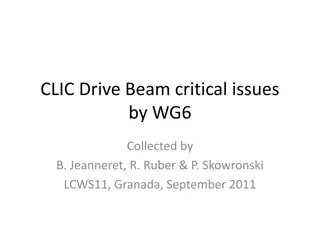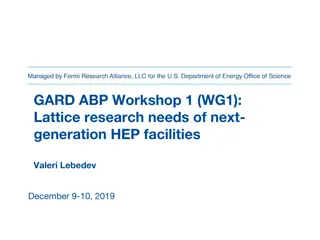Building a FAIR-Compliant Platform for AI-Ready Data in Particle Accelerators
This content discusses the development of a FAIR-compliant platform for AI-ready data in particle accelerators, highlighting the applications of machine learning in various accelerator facilities like CERN, PETRA-III, NSLS-II, HEPS, and more. It emphasizes the importance of high-quality data in acce
2 views • 25 slides
Advances in Particle Therapy: Slow Extraction and Dose Delivery at Medical Facilities
Medical facilities, like Heidelberg University Hospital, utilize advanced techniques such as slow extraction and raster scanning for precise dose delivery in particle therapy. The demands on these facilities include safe and precise beam parameters, uninterrupted therapy sessions, and fast irradiati
2 views • 23 slides
Introducing Turnkey's groundbreaking iPM instrument
\nIntroducing Turnkey's groundbreaking iPM instrument! Revolutionizing air quality analysis, it combines light extinction & scatter for precise airborne particle measurement. Now, track all PM size fractions simultaneously with unmatched accuracy. \nKEY FEATURES:\n1. Measures PM10, PM4 (respirable),
1 views • 2 slides
Understanding Comminution and Particle Size Reduction in Pharmaceutical Processes
Comminution is the process of reducing particle size from larger to smaller particles, crucial in various industries like pharmaceuticals. This operation involves milling, grinding, and size reduction to make raw materials usable. The particle size plays a significant role in pharmaceutical formulat
2 views • 50 slides
Linear Beam Optics and Particle Motion in Accelerator Physics
Explore the fundamental concepts of linear beam optics and particle motion in accelerator physics, covering topics such as design trajectory, path length, phase advance, transfer matrix, and more. Understand the intricacies of designing accelerators and the mathematical representations involved in o
0 views • 78 slides
Correlated Head-Tail Instability in Beam-Beam Collisions
The study discusses the impact of the cross wake force and correlated head-tail instability in collisions with a large crossing angle. It delves into the mechanism of beam-beam instability, cross wake force induction, mode coupling, and particle tracking simulations. Design parameters and instabilit
0 views • 34 slides
Injection Process in Particle Accelerators
The injection process in particle accelerators involves transferring beams efficiently with minimal loss and emittance dilution. It includes on-axis injection onto the reference orbit using septum magnets and fast kickers to maintain beam trajectory accuracy. The design aims to achieve precise beam
0 views • 22 slides
Current Status of Front End Systems in Particle Collider Research
David Neuffer presented the current status of front end systems for particle colliders on December 4, 2014. The presentation covered various aspects like baseline examples, beam characteristics, drift mechanisms, cooling methods, and simulation results. It provided insights into the operational mech
0 views • 15 slides
Efficiency Enhancement in PHITS: Variance Reduction Techniques for Particle and Heavy Ion Transport
Explore techniques for improving calculation efficiency in the PHITS Multi-Purpose Particle and Heavy Ion Transport code system. Topics covered include neutron deep penetration calculation, effective dose calculation, and use of variance reduction techniques to enhance Monte Carlo simulation efficie
0 views • 24 slides
Vacuum Technology for Particle Accelerators
This presentation covers the importance of vacuum technology in particle accelerators, focusing on particle loss due to collisions with residual gas molecules and the stringent vacuum requirements for storage rings and accelerators. It discusses the impact of circulating beams on vacuum deterioratio
0 views • 37 slides
Advancements in Beam Dynamics and Simulation at John Adams Institute
Explore the latest research highlights in beam dynamics and simulation conducted by Stewart T. Boogert at the John Adams Institute in collaboration with Royal Holloway. Learn about the groundbreaking work in wakefield measurement, achieving a beam size of 65 nm, development of beam delivery simulati
0 views • 15 slides
Understanding Beam Conditions and Effects in Particle Physics Experiments
Critical accelerator and beam conditions for E.C. Aschenauer's physics research at BNL are discussed, including effects on the main detector, consequences of crossing angle adjustments, important particle beam parameters, and the rotation of the ESR reference plane. Detailed information on beam dive
0 views • 8 slides
Critical Issues in CLIC Drive Beam by Working Group 6 at LCWS11
Issues identified in the CLIC Drive Beam project include RF stability and reliability, beam current stability, RF deflectors in combiner rings, synchrotron radiation power, beam dynamics, operability concerns, machine protection, and beam synchronization challenges. Key areas requiring attention inc
0 views • 5 slides
Beam-beam Effects in Future Hadron Colliders Workshop
Explore the beam-beam effects in the SPPC and future hadron colliders, presented at the International Workshop on High Energy Circular Electron-Positron Colliders. The workshop covers weak-strong beam-beam simulations, collision models, and parameter values for the SPPC. Detailed discussions on the
0 views • 32 slides
Analysis of Beam Tracking in IEEE 802.11-19/0007r0 Document
The document "January 2019.doc: IEEE 802.11-19/0007r0" discusses the necessity of beam tracking in the 11md draft. It explores whether beam tracking should be mandatory or optional and provides insights into DMG beam tracking procedures for both TX and RX in wireless communication. The document emph
0 views • 11 slides
Revolutionizing Oral Care with Beam Connected Toothbrush and Insurance Plan
Beam Technologies offers the Beam Brush, a smart toothbrush that integrates with a dental insurance plan to promote preventative oral care, reduce costs, and provide valuable insights on oral health. The Beam Brush and accompanying app track and reward good oral hygiene habits, detect oral diseases,
0 views • 5 slides
Understanding Beam Lifetime and Injection Considerations at CEPC
Delve into the intricacies of beam lifetime and injection considerations at the CEPC, exploring topics such as beam-gas scattering, quantum lifetime, Touschek lifetime, and injection modes. Discover the crucial factors affecting beam stability and injection efficiency in particle accelerators.
0 views • 20 slides
Lattice Research Needs for Next-Generation HEP Facilities
Lattice research is vital for determining the characteristics of accelerators, colliders, and storage rings. High beam brightness is crucial for achieving goals like luminosity and beam loss reduction. The main barriers to higher beam brightness include instabilities and particle loss. General requi
0 views • 13 slides
Advanced Beam Diagnostics and Control Systems in Beam Physics
Cutting-edge detector technologies like KAPTURE and KALYPSO are revolutionizing beam diagnostics with ultra-fast Terahertz detectors and advanced line-camera systems. The POF III and POF IV projects focus on extreme beam control and diagnostics, aiming to probe femto-scale dynamics of relativistic p
0 views • 8 slides
Overview of Electron/Positron Injector Linac Upgrades at KEK
The recent status of the Electron/Positron Injector Linac at KEK, presented by Kazuro Furukawa, highlights the mission to achieve 40 times higher luminosity in the SuperKEKB collider. The upgrades include low emittance, low energy spread injection beams with higher beam current, new high-current pho
0 views • 23 slides
Ion Beam Intensity Enhancement Through Electron Heating in Collider Experiments
The study discusses electron heating of ions in collider experiments at the Collider V. ParkhomchukBINP facility in Novosibirsk. It explores the effects of electron cooling on ion beams, ion beam oscillations, losses, and ion beam intensity enhancement. Various factors such as ion charge, classical
0 views • 9 slides
Understanding Transverse Motion in Particle Accelerators
Exploring the formalism and calculations related to transverse motion in particle accelerators, including the Hill equation, transfer matrices, lattice functions, and example drift calculations. The content delves into the mathematical foundations and practical applications of analyzing particle bea
0 views • 16 slides
Highlights of the 65th ICFA Advanced Beam Dynamics Workshop
The 65th ICFA Advanced Beam Dynamics Workshop featured insightful presentations on high currents, luminosity, and beam behaviors. Topics included beam pipe scrubbing, non-gaussian beam tails, and detector backgrounds. Presenters discussed progress in FCCee design, focus magnets, and beampipe concept
0 views • 32 slides
Achieving High Average Beam Polarization in Particle Colliders
Detailed discussion on achieving high average beam polarization in particle colliders like CEPC, focusing on longitudinal polarized colliding beams, beam polarization requirements, basic formulas, and strategies for maintaining beam polarization during physics runs. Emphasis on scenarios involving s
0 views • 16 slides
ESSnuSB Project - Linac Upgrade for Neutrino Beam Generation
Explore the ESSnuSB project's linac upgrade featuring beam pulsing schemes and modifications, aiming to provide an additional 5 MW of beam power for neutrino generation. The upgrade options, pulse structure, beam parameters at 2.5 GeV, and different pulsing schemes are detailed with images and descr
0 views • 10 slides
Study on Energetic Particle Transport and Loss in Magnetic Confinement Systems
Investigation into energetic particle transport and loss induced by helically-trapped energetic-ion-driven resistive interchange modes in the Large Helical Device (LHD) for sustaining high-temperature and high-density plasmas. Utilizing neutron diagnostics and comprehensive neutron monitors, this st
0 views • 21 slides
Electron Lenses in Particle Accelerators: Advancements and Applications
Explore the use of electron lenses in particle accelerators for space-charge compensation, Landau damping, halo collimation, and beam-beam compensation. Learn about their history, applications in Tevatron and RHIC colliders, and current research areas. Electron lenses have shown promise in enhancing
0 views • 44 slides
Update on UE Beam Assumption for RRM Test Cases in 3GPP Meetings
The latest developments in 3GPP meetings regarding UE beam assumption for RRM test cases are outlined. Discussions include the need for UE beam type assumptions, updates to test cases for FR2, and upcoming presentations focusing on specific test cases and beam assumptions per test group. Test purpos
0 views • 9 slides
Introduction to Particle Physics at U. Wisconsin: Physics 535
Dive into the captivating world of particle physics with Physics 535 at University of Wisconsin. Explore phenomena, delve into Quantum Field Theory and Elementary Particle Physics, and prepare for research work. Engage in in-person lectures supplemented by Zoom for those in isolation. Utilize textbo
0 views • 8 slides
Overview of Mu2e Slow Extraction Workshop at Fermilab by Vladimir Nagaslaev
This content discusses the Mu2e project at Fermilab, focusing on slow extraction techniques for beam delivery. It covers beam facilities, characteristics of Muon Campus, design requirements, beam losses, new MARS simulations, and losses in the extraction beam line. Details include beam kinetics, spi
0 views • 17 slides
Understanding Particle Filters in Non-parametric Systems
Particle filters, also known as non-parametric filters, are a powerful tool for state estimation in dynamic systems. These filters represent density using a set of samples drawn from the density, known as particles. Through resampling and reweighting, particle filters track the state of a system ove
0 views • 19 slides
Overview of CAIN Particle Tracking Code for High-Energy Colliders
CAIN is a particle tracking code used for high-energy collider simulations since 1984. Initially named ABEL, it evolved to include beam-laser interactions for gamma-gamma colliders. The code, written in FORTRAN 90, handles beam-beam and external fields, with a structure where all particles are store
0 views • 17 slides
Exploring Particle Physics at CERN: A Multinational Conference Experience
Participants from various European cities engage in a video conference at CERN, discussing particle physics topics like pronunciation of particle names, technical terms, and multiple-choice questions. Interactions involve learning about the Large Hadron Collider, particle collisions, and particle de
0 views • 25 slides
Exploring Particles and Detectors in Particle Physics Conference
Delve into the world of particle physics with a focus on particle detectors and pronunciation of particle names. Join a diverse group of participants from various countries as they discuss topics like the Large Hadron Collider and particle interactions. Test your pronunciation skills and learn about
0 views • 25 slides
Performance Studies of dRICH Detector at ePIC Experiment
The Electron-Ion Collider ePIC experiment focuses on the performance studies of the dRICH detector for particle identification crucial in various physics channels. The detector features aerogel optimization, SiPM sensors, and test-beam analyses. Key capabilities include different techniques for part
0 views • 28 slides
Design of a 10 MeV Beamline for E-beam Irradiation at UITF Wastewater Facility
This paper discusses the design of a 10 MeV beamline at the Upgraded Injector Test Facility for electron beam irradiation, focusing on wastewater treatment for environmental restoration. The use of electron beam irradiation is highlighted as an effective method to remove pollutants like 1,4 dioxane
0 views • 9 slides
Particle Physics Quiz - Test Your Knowledge of the Universe!
Engage in a thrilling particle physics quiz with 7 questions to challenge your knowledge! From understanding mass to energy levels and particle interactions, test your skills and learn fascinating facts. Tick off energy steps for each correct answer as you explore the mysteries of the universe. Expl
0 views • 10 slides
Particle Therapy Market Analysis, Share, Trends, and Overview
Particle Therapy Market expansion is primarily propelled by factors such as the increasing incidence of cancer, heightened adoption of particle therapy in clinical research, continual technological advancements, and the proliferation of particle ther
1 views • 3 slides
Particle Size Analysis in Industrial Pharmacy: Methods and Importance
Particle size analysis is crucial in pharmacy for determining the size range and properties of particles. This lecture covers different methods of particle size analysis, such as microscopy, sieve analysis, sedimentation, and electronic determination, along with the importance of particle size in ph
0 views • 47 slides
Challenges and Design of High-Intensity Accumulator for Neutrino Experiments
The presentation discusses the challenges faced in designing an accumulator for high-intensity particle beams in neutrino experiments at ESS Lund, with a focus on beam loss management, injection efficiency, and intense beam physics issues. The design considerations include beam holding capacity, bea
0 views • 30 slides





































